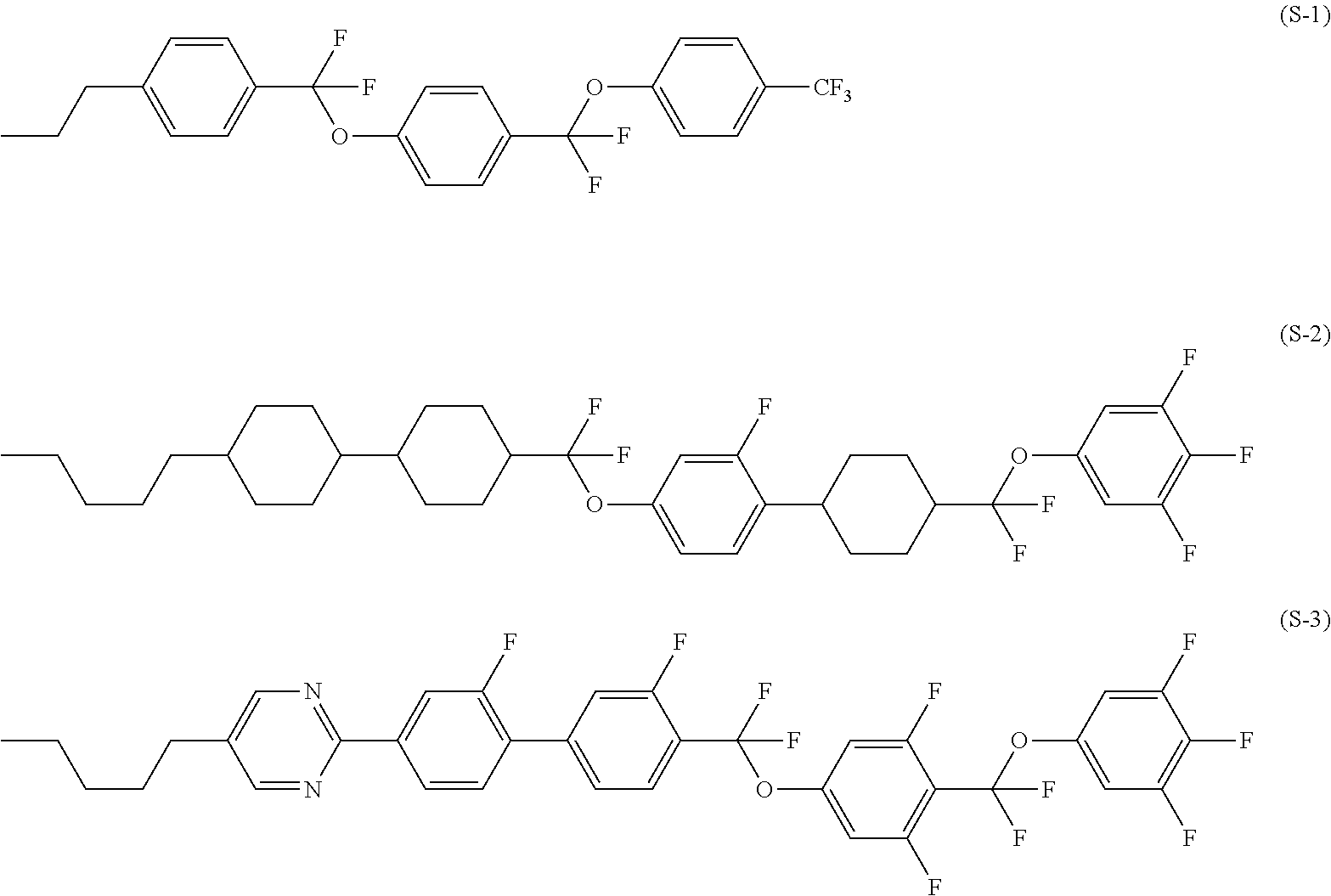Four-ring compound having a plurality of cf2o bonding groups, liquid crystal composition and liquid crystal display device
- Summary
- Abstract
- Description
- Claims
- Application Information
AI Technical Summary
Benefits of technology
Problems solved by technology
Method used
Image
Examples
example 1
Preparation of the Compound (No. 5)
[0195]
First Step:
[0196]The compound (e-1) (30.00 g) and THF (150 ml) were placed in a reaction vessel under an atmosphere of nitrogen, and the mixture was cooled to −74° C. sec-Butyllithium (1.07 M; n-hexane solution; 157.0 ml) was added dropwise in the temperature range of −74° C. to −70° C., and the stirring was continued for another 60 minutes. Dry ice (12.32 g) was added in the temperature range of −75° C. to −70° C., and the stirring was continued for another 60 minutes while the mixture was allowed to warm to 25° C. The reaction mixture was poured into ice-water, and the aqueous layer was extracted with toluene. The combined organic layers were washed with brine, and then dried over anhydrous magnesium sulfate. The solution was concentrated under reduced pressure, and the residue was washed with heptane to give the compound (e-2) (28.31 g; 78.3%).
Second Step:
[0197]The compound (e-2) (28.31 g), 2,2,4-trimethylpentane (60.0 ml) and toluene (60....
example 2
Preparation of the Compound (No. 31)
[0203]
First Step:
[0204]Dibromodifluoromethane (28.31 g) and THF (60 ml) were placed in a reaction vessel under an atmosphere of nitrogen. N,N,N′,N′,N″,N″-Hexaethylphosphinetriamine (68.97 g) in a THF (140 ml) solution was added dropwise under the conditions that the reaction temperature did not exceed 30° C., and the stirring was continued at 0° C. for another 1 hour. The compound (e-8) (20.00 g) in a THF (50 ml) solution was added dropwise under the conditions that the reaction temperature did not exceed 30° C., and the stirring was continued at 0° C. for another 20 hours. The reaction mixture was poured into water, and the aqueous layer was extracted with heptane. The combined organic layers were washed with water, 3N-hydrochloric acid and water, and then dried over anhydrous magnesium sulfate. The solution was concentrated under reduced pressure, and the residue was purified by silica gel chromatography (heptane) to give the compound (e-9) (19....
example 3
Preparation of the Compound (No. 3)
[0212]
First Step:
[0213]The compound (e-13) (75.00 g), 2,2,4-trimethylpentane (150.0 ml) and toluene (150.0 ml) were placed in a reaction vessel under an atmosphere of nitrogen, and the mixture was heated to 60° C. Propanedithiol (41.2 ml) was added dropwise, and the mixture was stirred for 90 minutes. Trifluoromethanesulfonic acid (123.20 g) was added slowly. The mixture was stirred at 60° C. for 60 minutes, and then stirred at 110° C. for 120 minutes. The reaction mixture was cooled to 25° C., and concentrated under reduced pressure. The residue was purified by recrystallization from t-butyl methyl ether to give the dithianylium salt (e-14) (78.38 g; 49.6%).
Second Step:
[0214]3,4,5-Trifluorophenol (e-7) (8.39 g), triethylamine (8.6 ml) and dichloromethane (70 ml) were placed in a reaction vessel under an atmosphere of nitrogen, and the mixture was cooled to −70° C. The dithianylium salt (e-14) (20.00 g) in a dichloromethane (140 ml) solution was sl...
PUM
| Property | Measurement | Unit |
|---|---|---|
| Composition | aaaaa | aaaaa |
Abstract
Description
Claims
Application Information
 Login to View More
Login to View More - R&D
- Intellectual Property
- Life Sciences
- Materials
- Tech Scout
- Unparalleled Data Quality
- Higher Quality Content
- 60% Fewer Hallucinations
Browse by: Latest US Patents, China's latest patents, Technical Efficacy Thesaurus, Application Domain, Technology Topic, Popular Technical Reports.
© 2025 PatSnap. All rights reserved.Legal|Privacy policy|Modern Slavery Act Transparency Statement|Sitemap|About US| Contact US: help@patsnap.com



